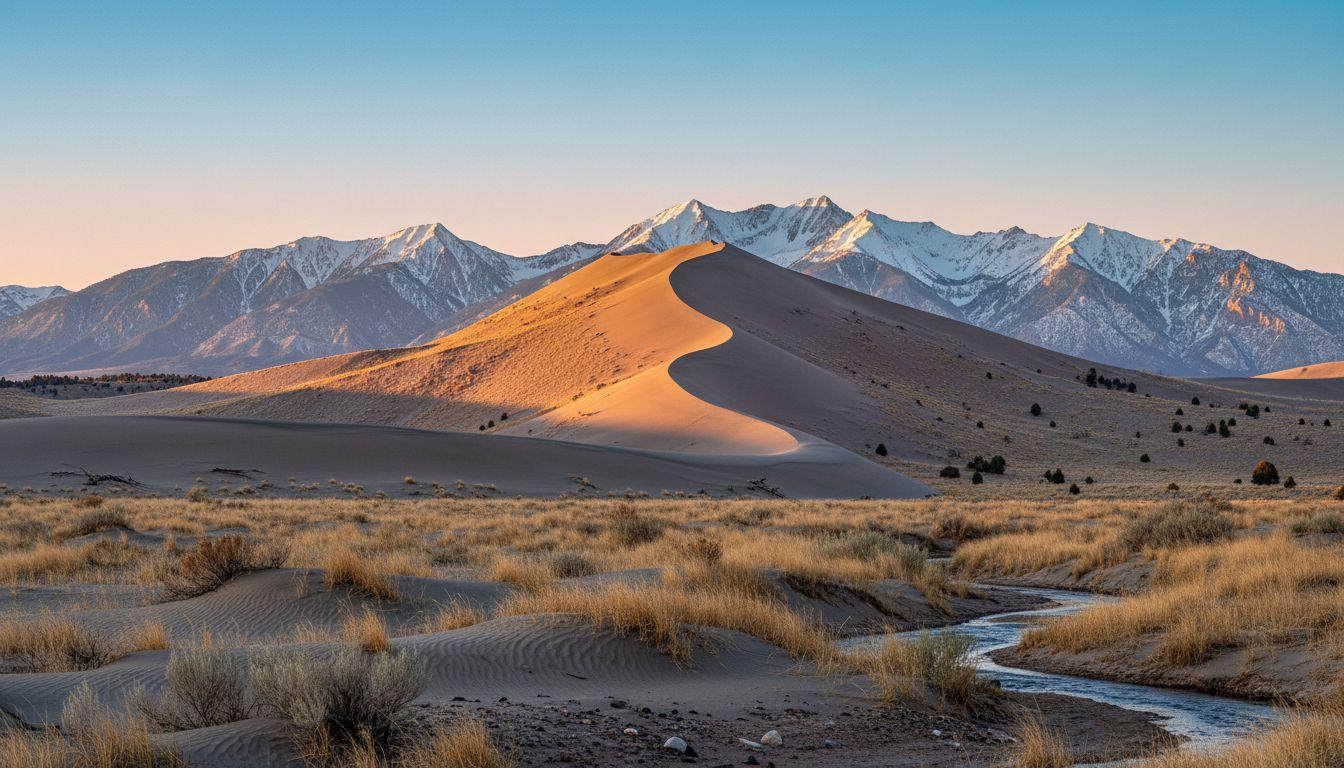At 6:47 AM on November 12, 2025, golden light touches the crest of Star Dune while snow glows on Sangre de Cristo peaks 8 miles away. This is Great Sand Dunes National Park, where 750-foot sand mountains rise impossibly at the base of 13,000-foot Rocky Mountain summits. Steam rises from morning coffee at Pinyon Flats Campground while Medano Creek whispers across empty dunes. Four hours from Denver, 500,000 annual visitors discover what Yosemite’s millions overlook: authentic solitude in North America’s most surreal landscape.
Where golden dunes meet snow-capped peaks
Great Sand Dunes occupies 149,000 acres of Colorado’s San Luis Valley, 235 miles south of Denver at elevations ranging from 7,500 to 13,604 feet. Star Dune rises 741 feet above the valley floor, taller than any sand formation in North America. The Sangre de Cristo Mountains provide an impossible backdrop of jagged peaks.
November transforms this geographic anomaly into visual poetry. Air temperatures hover at 46°F while sand warms to 55°F under afternoon sun. Fresh snow dusts mountain peaks above 11,000 feet, creating stark color contrasts: warm amber dunes against cool blue-white summits. Medano Creek, fed by snowmelt, creates rare reflections at the dune field’s eastern edge before vanishing into sand by late spring.
The landscape that defies logic
How 440,000 years built America’s tallest dunes
Westerly winds have swept sand from the Rio Grande’s ancient floodplains for 440,000 years, depositing grains against the Sangre de Cristo mountain wall. The result: 30 square miles of sand rising toward alpine peaks in geological slow motion. Park entrance costs $30 per vehicle, valid for seven days.
Star Dune marks the highest point at 741 feet, but High Dune (693 feet) offers easier access via a 2.5-mile trail from the parking area. The hike through soft sand requires 2-3 hours round trip, climbing 693 vertical feet. November temperatures shift dramatically: cool mornings at 25°F, warming to 46-49°F by afternoon.
The color palette changes hourly
Morning light (6:47 AM sunrise in November) paints dunes soft gold against purple mountain shadows. Midday sun bleaches sand nearly white, reaching surface temperatures of 55°F. Sunset (4:47 PM) transforms the landscape to deep amber and rust.
Night brings star-filled darkness. Minimal light pollution reveals the Milky Way arching over dunes. The park earned International Dark Sky designation in 2019, offering ranger-led stargazing programs every Friday and Saturday night through December.
What makes November the secret season
The solitude factor
Summer brings crowds and surface sand temperatures exceeding 140°F. November offers comfortable hiking conditions with visitor numbers dropping 70% after Labor Day. Only 420 people visit daily in November versus 3,850 in July. This creates authentic wilderness experience just four hours from Denver.
Snow typically dusts peaks above 11,000 feet by late October, persisting through April. The contrast peaks in November: golden dunes against fresh white summits. According to park visitor surveys, November ranks as the most photogenic month for dune-mountain contrasts.
Activities beyond hiking
Sand sledding and sandboarding work year-round. Rental equipment costs $18.50 per day at the Oasis Store. Fat-tire biking explores Medano Pass Primitive Road when conditions allow. The primitive road typically closes November 15 through May 15 due to snow.
Hiking remains the primary attraction. The 2.5-mile trail to High Dune attracts most visitors, requiring 3 hours round trip. Serious hikers continue to Star Dune (5 miles round trip, 741 feet elevation gain). Water requirements reach 0.5 liters per hour minimum, even in cooler November temperatures.
The authentic Colorado experience at $30
While Yellowstone and Yosemite process 4.5 million and 3.6 million visitors annually, Great Sand Dunes preserves something rarer: the sensation of discovering wilderness few others know. Pinyon Flats Campground charges $16.48 per night for sites with Sangre de Cristo views. Nearby Alamosa (25 miles away) offers motels from $92-157 per night.
The dunes shift constantly under wind averaging 12-18 mph in November. Your footprints vanish overnight. Morning reveals virgin sand stretching toward mountain peaks unchanged for 440,000 years. Travel research published in 2025 confirms this park offers the most dramatic elevation contrast of any US national park.
Your questions about Great Sand Dunes National Park answered
When should I visit for best conditions?
Late spring (April-May) and early fall (September-October) offer warmest temperatures (60-70°F) and flowing Medano Creek. November through March brings snow, cold, and solitude with temperatures ranging 25-55°F. Summer exceeds 90°F with dangerous midday sand temperatures. Avoid holiday weekends year-round for authentic experience.
How do I reach the park from Denver?
Drive south on I-25 to Walsenburg, then west on US-160 to US-150 (4 hours, 235 miles). Gas prices along this route average $3.59 per gallon. Alamosa Regional Airport offers daily Denver connections with three rental car companies. Average November rental costs reach $68.25 per day for midsize SUVs.
How does this compare to Death Valley or White Sands?
Great Sand Dunes offers unique mountain backdrop absent at White Sands (flat gypsum desert) and Death Valley (extreme heat, distant peaks). Dunes here rise 741 feet versus White Sands’ 60 feet maximum. November remains accessible with 46°F highs versus Death Valley’s harsh conditions. Annual visitor counts favor solitude: 500,000 here versus Death Valley’s 2.1 million.
At 4:47 PM, November sun sinks toward the San Juan Mountains 90 miles west. Star Dune catches final light, glowing deep amber while Sangre de Cristo peaks fade to purple silhouette. Wind whispers across virgin sand at 15 mph. Tomorrow morning, footprints will vanish. The mountains will remain. The dunes will shift another grain.
